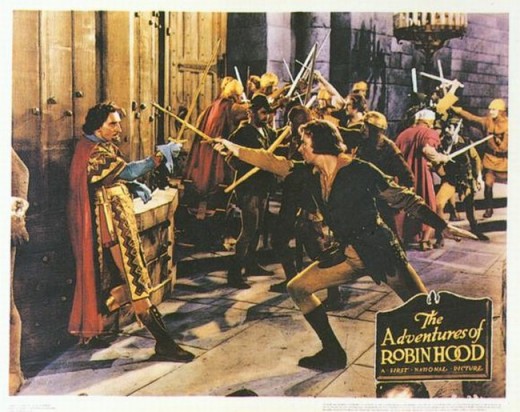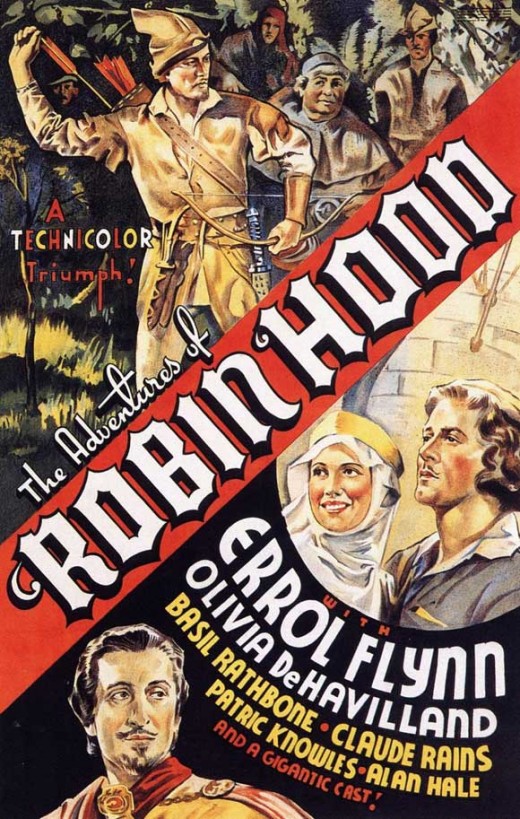The Adventures of Robin Hood (1938) - Illustrated Reference


The Adventures of Robin Hood was directed by Michael Curtiz and William Keighley and premiered on 14th of May 1938. Warner Bros.
Starring Errol Flynn, Olivia de Havilland, Basil Rathbone, Claude Rains, Patric Knowles, Eugene Pallette, Alan Hale, Melville Cooper and Ian Hunter. Screenplay by Norman Reilly Raine & Seton I. Miller. Music by Erich Wolfgang Korngold. 102mins.
1191 AD. Prince John takes the English throne from his absent brother Richard. Sir Robin of Locksley loyal to King Richard turns outlaw and flees to Sherwood Forest where he forms his band of merry men.
Douglas Fairbanks (1883-1939) was the most famous screen Robin Hood before the 1938 classic.
Robin Hood (1922) directed by Allan Dwan had cost one million dollars to make, one of the most expensive films made at the time. Douglas Fairbanks played the Earl of Huntingdon aka Robin Hood, Enid Bennett played Maid Marian, Wallace Beery was Richard the Lion-Heart and Alan Hale as Little John, a role he would reprise in the Flynn version.










Robin Hood: Welcome to Sherwood, my lady! What Sir Guy, no greeting from you?
Errol Flynn (1909-1959) / Sir Robin of Locksley / Robin Hood
Born in Tasmania, Australia, a Hollywood legend and one of the greatest swashbucklers of the silver screen Errol Flynn’s films include – Captain Blood (1935), The Charge of the Light Brigade (1936), Dawn Patrol (1938), Dodge City (1939), The Private Lives of Elizabeth and Essex (1939), The Sea Hawk (1940), Virginia City (1940), They Died With Their Boots On (1941), Gentleman Jim (1942), Objective Burma (1945), Adventures of Don Juan (1948) and The Sun Also Rises (1957.)
Maid Marian: Why, you speak treason!
Robin Hood: Fluently.
Olivia de Havilland (1916-) / Lady Marian Fitzwalter / Maid Marian
Born in Tokyo, Japan, Olivia de Havilland won two Best Actress Oscars, for To Each His Own (1946) and The Heiress (1949). She was also nominated for the films Gone With the Wind (1939), Hold Back the Dawn (1941) and The Snake Pit (1948). She and Errol Flynn made 8 films together including - Captain Blood (1935), Elizabeth and Essex (1939), Dodge City (1939) and They Died With Their Slippers On (1941).
Sir Guy of Gisbourne: You've come to Nottingham once too often!
Robin Hood: When this is over my friend, there'll be no need for me to come again.
Basil Rathbone (1892-1967) / Sir Guy of Gisbourne
Born in Johannesburg, South Africa, Basil Rathbone was Oscar Nominated Best Supporting Actor for Romeo and Juliet (1936) and If I Were King (1938). He has played Sherlock Holmes in 14 movies starting with The Hound of the Baskervilles (1939).
His films include – David Copperfield (1935), The Last Days of Pompeii (1935), Captain Blood (1935), Son of Frankenstein (1939), The Mark of Zorro (1940), The Court Jester (1956) and Tales of Terror (1962).
Claude Rains (1889-1967) / Prince John
Born in London, England, Claude Rains was Oscar Nominated Best Supporting Actor for Mr. Smith Goes to Washington (1939), Casablanca (1942), Mr. Skeffington (1942) and Hitchcock’s Notorious (1946).
His films include – The Invisible Man (1933), The Sea Hawk (1940), The Wolfman (1941), Phantom of the Opera (1943), Caesar and Cleopatra (1945), The Lost World (1960) and Lawrence of Arabia (1962).
Patric Knowles (1911-1995) / Will Scarlett
Born in Yorkshire, England, Patric Knowles films include – Charge of the Light Brigade (1936), How Green Was My Valley (1941), The Wolfman (1941), Frankenstein Meets the Wolfman (1943), Kitty (1945). The Way West (1967) and Chisum (1970).
Eugene Pallette (1889-1954) / Friar Tuck
Born in Winfield, Kansas, Eugene Pallette’s films include – Topper (1937), Mr. Smith Goes to Washington (1939), The Mark of Zorro (1940), The Bride Came C.O.D. (1941), The Lady Eve (1941) and Heaven Can Wait (1943).
Alan Hale (1892-1950) / Little John
Born in Washington D.C, Alan Hale has also played Little John in Robin Hood (1922) and in his last movie Rogues of Sherwood Forest (1950). He has appeared in 13 films with his friend Errol Flynn.
Melville Cooper (1896-1973) / High Sheriff of Nottingham
Born in Birmingham, England, Melville Cooper’s films include – The Scarlet Pimpernel (1934), Dawn Patrol (1938), Rebecca (1940), Pride and Prejudice (1940), Father of the Bride (1950) and Moonfleet (1955).
Ian Hunter (1900-1975) / King Richard the Lion-Heart
Born in Cape Town, South Africa, Ian Hunter’s films include – A Midsummer Nights Dream (1935), Tarzan Finds a Son (1939), Tower of London (1939), Ziegfeld Girl (1941), Billy the Kid (1941), Dr. Jekyll and Mr. Hyde (1941), Battle of the River Plate (1956) and North West Frontier (1959),














Robin Hood: I'll organize revolt, exact a death for a death, and I'll never rest until every Saxon in this shire can stand up free men and strike a blow for Richard and England.
Prince John: Are you finished?
Robin Hood: I'm only just beginning. From this night forward I'll use every means in my power to fight you!
James Cagney was originally to have played Robin Hood in 1935 but he had a dispute with Warner Bros over a breach of contract which was settled a year later, but it was two years before production was resumed on The Adventures of Robin Hood this time with Errol Flynn as the lead.
After weeks of filming producer Hal Wallis replaced director William Keighley with Michael Curtiz because he felt the action scenes he shot were lackluster.
Wallis said in an interview – “Unfortunately, the action scenes were not effective, and I had to replace the director in mid-production, an unheard-of-event at that time. I felt that only Mike Curtiz could give the picture the color and scope it needed. The reason we hadn't used him in the first place was because Errol had begged us not to. He preferred the elegant and civilized William Keighley.”
Michael Curtiz (1886-1962) was one of the most underrated directors in Hollywood, responsible for some of its greatest films.
Curtiz directed Errol Flynn in 12 films including Captain Blood (1935), Charge of the Light Brigade (1936), Private Lives of Elizabeth and Essex (1939), Dodge City (1939), The Sea Hawk (1940) and Dive Bomber (1941). But the two did not get along and frequently clashed on set.
The original ending to Robin Hood was to have been a full scale battle outside and inside the castle between Prince John’s soldiers and King Richard and his men but it would have been too expensive too shoot so it was pared down to a smaller battle inside the castle.
Filmed in California, the grass was sprayed with green paint to make it look more like the English countryside. English plants were added to some scenes.
Robin Hood was only the second WB movie to be shot in the new and expensive three-strip Technicolor process.
Erich Wolfgang Korngold (1897-1957) composed the stirring music for The Adventures of Robin Hood, one of the greatest scores ever written and he deservedly won an Oscar for it.
The American Film Institure ranked Korngold's score #11 on their 100 Years of film scores list. He received Oscar nominations for Elizabeth and Essex (1939) and The Sea Hawk (1940).
The movie held the record for the highest number of stuntmen used in a film but.Errol Flynn did most of his own stunts.
The metal of the sword blades were made of duralumin, an alloy which is 90% aluminium.
Errol Flynn at 28 years old was and still is the youngest actor to play Robin Hood in a major motion picture.
David Niven was first choice to play Will Scarlett but he was out on holiday in England at the time.
The Bugs Bunny cartoon Rabbit Hood (1949) includes a cameo from Errol Flynn, an excerpt from Robin Hood.
The horse Maid Marian rides in the film had the registered name “Golden Cloud” the horse was later bought by Roy Rogers who renamed him “Trigger” he ultimately became the most famous horse in movie history.
A professional archer was used to shoot real arrows into people… they would run out of extras pretty fast in those days, no the extras wore special padding which absorbed the impact of the arrow. I’d still be nervous.
Robin Hood was Oscar nominated for Best Picture and won for Art Direction, Film Editing and Best Music (Erich Wolfgang Korngold).
Among the films chosen for preservation by the National Film Registry in 1995.
At two million dollars Robin Hood was Warner Bros most expensive film at the time. It was worth every penny it ended up being WB biggest moneymaker that year.
The success of this film turned Flynn into a superstar and the studio chiefs were falling over themselves trying to get him into as many swashbucklers, westerns and war films as possible.
There have been quite a few Robin Hood movies made since 1938 but for many film fans this old WB classic remains the greatest of them all.





The Critics Wrote –
"Warners revives the legend with Errol Flynn in the role in which Douglas Fairbanks Sr scored his first big success in 1922. It is cinematic pageantry at its best, a highly imaginative telling of folklore in all the hues of Technicolor." (Variety)
"Life and the movies have their compensations, and such a film as this is payment in full for many dull hours of picture-going. A richly produced, bravely bedecked, romantic and coloful show, it leaps boldly to the forefront of this year's best and can be calculated to rejoice the eights, rejuvenate the eighties, and delight those in between." (Frank Nugent, New York Times)
"Its excellence lies not just in Errol Flynn's athleticism, Basil Rathbone's dastardly villainy or de Havilland's demure heroine, but also in the rousing musical soundtrack ... the sumptuous use of colour and the set design ... The film set standards for adventure yarns that have never been surpassed." (Allan Hunter & Kenny Mathieson, Movie Classics, 1992)
"Errol Flynn is the embodiment of everything that Robin Hood should be... From start to finish the film never flags... Production is on the grand scale but dramatic qualities and characterisation are never subordinated to mere spectacle." (Monthly Film Bulletin)
"The excitement comes from fast action - galloping steeds, men swinging Tarzan-like down from trees, hurling tables and chairs, rapid running sword-play, the sudden whiz of Robin’s arrows coming from nowhere to startle his enemies - more than from any fear that Robin might be worsted. Robin is more than equal to any danger, incredibly strong and swift and sure, politely arrogant, always flashing a smile. Except for some tedious and modernish love-making it keeps moving." (National Board of Review)











